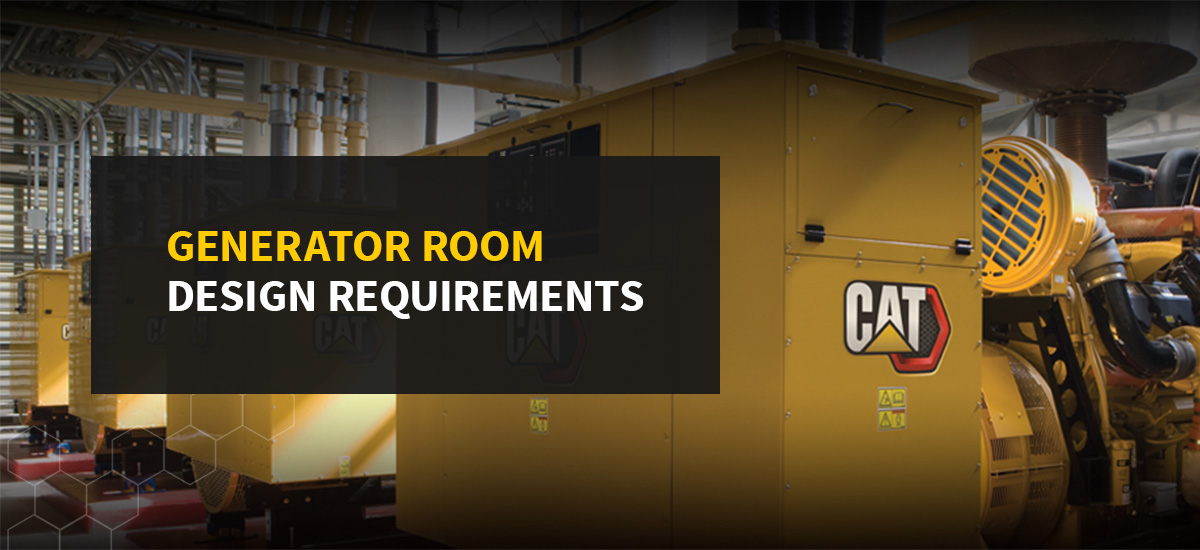
Designing a code-compliant, operationally efficient space has complex requirements. Organizations must deal with tight floor plans, coordinate multiple trades, and manage regulatory requirements.
Discover how to design and plan a generator room, and safety considerations for compliance adherence.
Role of a Well-Designed Generator Room
A well-designed generator room supports safe, continuous power delivery under varying conditions. Here’s why careful consideration matters.
1. Ensures Safety
A well-designed room accounts for spill containment, fire-rated construction, and proper separation between ignition sources and fuel storage. Safety design also considers human behavior, by:
- Directing gases away from occupied areas via exhaust systems.
- Having clear labels on electrical panels.
- Placing emergency stop buttons where they are reachable.
2. Supports Compliance
Design decisions must align with NFPA 110 for emergency power systems, the National Electrical Code (NFPA 70), Occupational Safety and Health Administration (OSHA) regulations, and local building and fire codes.
Compliance informs how rooms are laid out and what safety systems are included. When teams consider operational adherence, they can meet inspection requirements.
3. Provides Reliable Operation
Generators function best in predictable conditions. If the room is too cramped, hot, or poorly ventilated, high-end equipment becomes vulnerable to unplanned downtime.
Proper design makes room for adequate clearances for servicing, uninterrupted airflow paths, and a code-aligned layout minimizes equipment malfunction.
4. Improves Environmental Control
Moisture, airborne particulates, and corrosive vapors shorten component life. Effective generator rooms account for this by incorporating filtered air intakes, sealed cable penetrations, and vapor barriers where needed. Where ambient temperatures vary, supplemental heating or cooling systems may be necessary to maintain optimal operating conditions.
5. Dissipates Heat
Generators produce heat as a by-product of combustion and friction, and that heat must be moved out of the space quickly and efficiently. Heat buildup is one of the most common causes of generator alarms and automatic shutdowns.
Sizing ventilation systems based on the generator’s output and the room’s physical constraints reduces thermal stress and balances load capacity.
Sizing, Layout, and Access
The physical design of a generator room supports performance, safety, and long-term maintainability. Equipment specifications guide the starting point, but other factors ensure reliable system functionality.
Sizing
The generator room size must account for airflow and compliance. Factor in:
- Generator footprint: Start with the manufacturer’s dimensional specs, which include length, width, and height. Factor in any acoustic enclosures, vibration isolators, or sub-base fuel tanks.
- Minimum clearance requirements: NFPA 110 recommends a minimum of three feet at the front and sides of the generator for access, while NFPA 37 calls for five feet for clearance from the opening, combustible walls, and for general access.
Layout
A thoughtful generator room layout considers the flow of people, equipment, and airflow. Assess the following:
- Generator placement: Locate the unit centrally with sufficient clearance from walls and obstructions. Avoid placing the generator directly beneath air returns, sprinkler heads, or ductwork that may restrict airflow or cause condensation.
- Ventilation: Ducted exhaust must be routed outside the building with proper insulation. Per NFPA 37, maintain at least 10 feet of clearance from any building opening or air intake. Fan-assisted intake and discharge systems should be interlocked with the generator’s controller.
- Safety features: Include emergency stop switches at the entrance and within line of sight of the generator. Incorporate spill containment for fuel systems, noncombustible wall finishes, and fire-rated barriers between fuel tanks and electrical equipment.
- Monitoring systems: Install sensors for temperature, humidity, and exhaust gas. NFPA 110 requires a remote annunciator outside the generator room for emergency personnel and maintenance staff to view status.
Access
Access streamlines routine service and compliance with building and safety codes. To meet generator room requirements, consider:
- Doorway sizing: Doors should be wide enough for generator equipment, tanks, and parts to pass through. The minimum standard is 36 inches.
- Clearance for maintenance: Ensure that all serviceable parts of the generator have at least 36 inches of clearance in front.
- Egress and Americans with Disabilities Act (ADA) compliance: Every generator room must include at least one unobstructed exit path. For public or mixed-use spaces, door hardware must comply with ADA standards, which call for lever-style handles, a minimum door width of 32 inches, and threshold heights of up to 0.5 inches.
Safety Considerations
An effective design takes steps to protect personnel, infrastructure, and the surrounding environment. Explore some generator room safety requirements.
Ventilation
Without consistent airflow, heat and combustion gases can accumulate rapidly. Ensure safety through:
- Air intake and exhaust systems: NFPA 37 requires that intake and exhaust openings be positioned to prevent the re-entrainment of hot gases or combustion byproducts. Intakes must be clean, filtered, and located away from exhaust discharge. Maintain at least 10 feet between exhaust outlets and building openings.
- Mechanical ventilation: Mechanical ventilation systems should be interlocked with the generator controls. If airflow is compromised, the generator should automatically shut down or signal a fault. Intake fans should match or exceed the generator’s cubic feet per minute (CFM) requirement, while exhaust fans must sustain adequate air exchanges to prevent the buildup of radiant heat.
Fuel Storage and Handling
Fuel systems introduce flammability and environmental hazards, making separation, containment, and design layout critical to room safety. Indoor diesel tanks are limited to 660 gallons and housed within a 2-hour fire-rated room. Outdoor tanks require protected piping and spill containment. Maintain a minimum of five feet of separation between any fuel tank and ignition source or electrical gear.
Fire Protection
Install automatic-closing fire-rated dampers in all ventilation ducts. For rooms with indoor tanks, consider suppression systems to extinguish fires. Organizations can also use sprinkler systems with a dedicated riser.
Clearly mark emergency exits, shut-off switches, and hazard zones with durable, reflective signage in accordance with ANSI Z535.4 standards.
Noise Control
Generators produce a substantial amount of noise. Organizations should:
- Use factory-installed or acoustic enclosures to reduce noise at the source.
- Line exhaust ducts with high-temperature acoustic insulation to prevent noise transmission into adjacent rooms.
- Install acoustic panels or absorbing wall finishes to dampen reverberation.
Training
Safety systems are effective when people know how to use them. Training personnel ensures they understand:
- Routine operations: Operators should be familiar with startup sequences, transfer switch behavior, and fault indicators.
- Maintenance procedures: Train personnel on safe fueling practices, oil changes, coolant checks, and filter replacements. Lockout/tagout training per OSHA is mandatory for anyone working on or near live electrical equipment.
- Emergency protocols: Staff should know how to activate emergency stop functions and notify emergency responders.
Planning Your Generator Room
Effective generator room planning requires technical input and operational foresight. Here’s how to plan a generator room.
1. Coordinate With Stakeholders
Collaborate with electrical engineers, architects, facility managers, local inspectors, and utility providers to ensure designs get approved. Set recurring planning meetings and use shared documents or a project management platform to track decisions, drawing revisions, and vendor input.
2. Conduct Site Surveys
Conduct a thorough site survey to understand limitations and identify conflicts. Note the following:
- Load requirements
- Electrical infrastructure
- Existing ventilation systems
- Access constraints
- Building envelope conditions
3. Future-Proof Designs
Generator rooms need to account for facility expansion, increased energy loads, and technological evolution. Leave floor space and electrical conduit routes to accommodate larger units or additional capacity down the line. Consider scalable power systems that allow load sharing or redundancy.
4. Schedule Inspections
Depending on your region, different agencies may review fire protection, mechanical systems, electrical work, or ADA compliance. Schedule pre-inspections with local code officials to validate design and ensure readiness. Keep in mind that NFPA and local codes require verified performance for emergency power transfer and ventilation.
5. Use Digital Tools
Digital tools make generator room planning faster and more precise. Tools like SpecSizer help you determine generator capacity based on load type and usage profile.
Others, like Power Hub, provide centralized access to installation tools and customization solutions.
Get Power Solutions From Thompson Machinery
If you’re planning a generator room or upgrading an existing one, partner with Thompson Machinery. As the exclusive Cat® dealer for Middle Tennessee, West Tennessee, and North Mississippi, we understand power system operating and compliance requirements.
We help you size the right system and plan for proper installation to meet regulatory standards. Our team provides maintenance services to ensure systems work properly.
Contact us today to speak with a technical advisor.





